Using the Contrast Boundary Concentration of LST for the Earthquake Approach Assessment in Turkey, 6–8 February 2023
Abstract
1. Introduction
2. Materials and Methods
2.1. Study Area
- Epicenter 1: Atalar (coordinates: 37.17° N, 37.03° E), 6 February 2023, 7.8 Mw;
- Epicenter 2: Nurdagı (coordinates: 37.13° N, 36.94° E), 6 February 2023, 6.7 Mw.
2.2. Data
- Ground-based temperature data are publicly available from the Weather Underground service [42]. Using ground-based temperature data, we aimed to minimize the influence of solar radiation and maximize the contribution of subsurface heat.
- Information on the epicenters (coordinates, date and magnitude) of earthquakes that occurred on 6–8 February 2023 and in the subsequent period, provided by the USGS Earthquake Hazards Program, was used as input data [43].
2.3. Methodology
3. Results
3.1. Studying the Heating of the Earth’s Crustal Surface
3.2. Changes of LST Contrast Boundaries Concentration
4. Discussion
- Is there a spatial relationship between the localization of earthquake epicenters and anomalies in the contrast boundaries concentration map?
- Are there any other indicators calculated from Landsat satellite images (e.g., spectral indices) that also increased before the February 2023 earthquakes and then decreased?
- Do maps show the location of aftershock epicenters?
- What is the hazard of new major earthquakes one year on?
5. Conclusions
Author Contributions
Funding
Data Availability Statement
Acknowledgments
Conflicts of Interest
References
- Dal Zilio, L.; Ampuero, J.P. Earthquake doublet in Turkey and Syria. Commun. Earth Environ. 2023, 4, 71. [Google Scholar] [CrossRef]
- Karabulut, H.; Güvercin, S.E.; Hollingsworth, J.; Konca, A.Ö. Long silence on the East Anatolian Fault Zone (Southern Turkey) ends with devastating double earthquakes (6 February 2023) over a seismic gap: Implications for the seismic potential in the Eastern Mediterranean region. J. Geol. Soc. 2023, 180, jgs2023-021. [Google Scholar] [CrossRef]
- Provost, F.; Karabacak, V.; Malet, J.P.; Van der Woerd, J.; Meghraoui, M.; Masson, F.; Ferry, M.; Michéa, D.; Pointal, E. High-resolution co-seismic fault offsets of the 2023 Türkiye earthquake ruptures using satellite imagery. Sci. Rep. 2024, 14, 6834. [Google Scholar] [CrossRef] [PubMed]
- Scendoni, R.; Cingolani, M.; Tambone, V.; De Micco, F. Operational Health Pavilions in Mass Disasters: Lessons Learned from the 2023 Earthquake in Turkey and Syria. Healthcare 2023, 11, 2052. [Google Scholar] [CrossRef] [PubMed]
- Ghosh, A.; Holt, W.E.; Bahadori, A. Role of large-scale tectonic forces in intraplate earthquakes of central and eastern North America. Geochem. Geophys. Geosyst. 2019, 20, 2134–2156. [Google Scholar] [CrossRef]
- Cui, Y.; Huang, J.; Zeng, Z.; Zou, Z. CO Emissions Associated with Three Major Earthquakes Occurring in Diverse Tectonic Environments. Remote Sens. 2024, 16, 480. [Google Scholar] [CrossRef]
- Ning, L.; Hui, C.; Cheng, C. Exploring the Dynamics of Global Plate Motion Based on the Granger Causality Test. Appl. Sci. 2021, 11, 7853. [Google Scholar] [CrossRef]
- Nath, B.; Singh, R.P.; Gahalaut, V.K.; Singh, A.P. Dynamic Relationship Study between the Observed Seismicity and Spatiotemporal Pattern of Lineament Changes in Palghar, North Maharashtra (India). Remote Sens. 2022, 14, 135. [Google Scholar] [CrossRef]
- Das, D.; Mallik, J. Koyna earthquakes: A review of the mechanisms of reservoir-triggered seismicity and slip tendency analysis of subsurface faults. Acta Geophys. 2020, 68, 1097–1112. [Google Scholar] [CrossRef]
- Fitzenz, D.D.; Miller, S.A. A forward model for earthquake generation on interacting faults including tectonics, fluids, and stress transfer. J. Geophys. Res. Solid Earth 2001, 106, 26689–26706. [Google Scholar] [CrossRef]
- Nahornyi, V.V.; Pigulevskiy, P. Vibration forecast in Europe from the results of groundwater monitoring on the territory of Ukraine. MM Sci. J. 2022, 5926–5930. [Google Scholar] [CrossRef]
- Conti, L.; Picozza, P.; Sotgiu, A. A critical review of ground based observations of earthquake precursors. Front. Earth Sci. 2021, 9, 676766. [Google Scholar] [CrossRef]
- Picozza, P.; Conti, L.; Sotgiu, A. Looking for earthquake precursors from space: A critical review. Front. Earth Sci. 2021, 9, 676775. [Google Scholar] [CrossRef]
- Lee, H.A.; Hamm, S.-Y.; Woo, N.C. Pilot-Scale Groundwater Monitoring Network for Earthquake Surveillance and Forecasting Research in Korea. Water 2021, 13, 2448. [Google Scholar] [CrossRef]
- Sekertekin, A.; Inyurt, S.; Yaprak, S. Pre-seismic ionospheric anomalies and spatio-temporal analyses of MODIS Land surface temperature and aerosols associated with Sep, 24 2013 Pakistan Earthquake. J. Atmos. Sol.-Terr. Phys. 2020, 200, 105218. [Google Scholar] [CrossRef]
- Semenov, V.; Ladanivskyy, B.; Petrishchev, M. Emergence of earthquakes footprint in natural electromagnetic field variations. Geodynamics 2018, 2, 65–70. [Google Scholar] [CrossRef]
- Albano, M.; Chiaradonna, A.; Saroli, M.; Moro, M.; Pepe, A.; Solaro, G. InSAR Analysis of Post-Liquefaction Consolidation Subsidence after 2012 Emilia Earthquake Sequence (Italy). Remote Sens. 2024, 16, 2364. [Google Scholar] [CrossRef]
- Boudriki Semlali, B.-E.; Molina, C.; Park, H.; Camps, A. First Results on the Systematic Search of Land Surface Temperature Anomalies as Earthquakes Precursors. Remote Sens. 2023, 15, 1110. [Google Scholar] [CrossRef]
- Mahmood, I. Anomalous variations of air temperature prior to earthquakes. Geocarto Int. 2019, 36, 1396–1408. [Google Scholar] [CrossRef]
- Chalyi, O.; Diaconescu, M.; Gurova, I.; Lisovyi, Y.; Pigylevsky, P.; Shcherbina, S.; Shevtsov, A.; Shumlianska, L. The cause of high intensity of seismicity in Ukraine. Visnyk Taras Shevchenko Natl. Univ. Kyiv Geol. 2018, 4, 38–45. [Google Scholar] [CrossRef]
- Bhardwaj, A.; Singh, S.; Sam, L.; Joshi, P.K.; Bhardwaj, A.; Martín-Torres, F.J.; Kumar, R. A review on remotely sensed land surface temperature anomaly as an earthquake precursor. Int. J. Appl. Earth Obs. Geoinf. 2017, 63, 158–166. [Google Scholar] [CrossRef]
- Guo, A.; Xu, Y.; Jiang, N.; Wu, Y.; Gao, Z.; Li, S.; Xu, T.; Bastos, L. Analyzing correlations between GNSS retrieved precipitable water vapor and land surface temperature after earthquakes occurrence. Sci. Total Environ. 2023, 872, 162225. [Google Scholar] [CrossRef] [PubMed]
- Guo, A.; Jiang, N.; Xu, Y.; Xu, T.; Wu, Y.; Li, S.; Gao, Z. Co-seismic characterization analysis in PWV and land-atmospheric observations associated with Luding Ms 6.8 earthquake occurrence in China on September 5, 2022. Geomat. Nat. Hazards Risk 2023, 14, 2279494. [Google Scholar] [CrossRef]
- Ringler, A.T.; Steim, J.; Wilson, D.C.; Widmer-Schnidrig, R.; Anthony, R.E. Improvements in seismic resolution and current limitations in the Global Seismographic Network. Geophys. J. Int. 2020, 220, 508–521. [Google Scholar] [CrossRef]
- International Federation of Digital Seismograph Networks. Available online: https://www.fdsn.org/networks (accessed on 12 July 2024).
- Nolte, K.A.; Tsoflias, G.P.; Holubnyak, Y.; Raney, J.; Wreath, D. Designing monitoring networks for local earthquakes. J. Geophys. Eng. 2022, 19, 75–84. [Google Scholar] [CrossRef]
- Hauksson, E.; Yoon, C.; Yu, E.; Andrews, J.R.; Alvarez, M.; Bhadha, R.; Thomas, V. Caltech/USGS Southern California Seismic Network (SCSN) and Southern California Earthquake Data Center (SCEDC): Data availability for the 2019 Ridgecrest sequence. Seismol. Res. Lett. 2020, 91, 1961–1970. [Google Scholar] [CrossRef]
- Aoi, S.; Asano, Y.; Kunugi, T.; Kimura, T.; Uehira, K.; Takahashi, N.; Ueda, H.; Shiomi, K.; Matsumoto, T.; Fujiwara, H. MOWLAS: NIED observation network for earthquake, tsunami and volcano. Earth Planets Space 2020, 72, 126. [Google Scholar] [CrossRef]
- Alver, F.; Kılıçarslan, Ö.; Kuterdem, K.; Türkoğlu, M.; Şentürk, M.D. Seismic Monitoring at the Turkish National Seismic Network (TNSN). Summ. Bull. Int. Seismol. Cent. 2019, 53, 41–58. [Google Scholar] [CrossRef]
- Li, Z. Recent advances in earthquake monitoring I: Ongoing revolution of seismic instrumentation. Earthq. Sci. 2021, 34, 177–188. [Google Scholar] [CrossRef]
- Panchal, H.; Saraf, A.K.; Das, J.; Dwivedi, D. Satellite based detection of pre-earthquake thermal anomaly, co-seismic deformation and source parameter modelling of past earthquakes. Nat. Hazards Res. 2022, 2, 287–303. [Google Scholar] [CrossRef]
- USGS. Landsat Missions. Available online: https://www.usgs.gov/landsat-missions (accessed on 12 July 2024).
- Huda, D.N.; Shidiq, I.P.A. Spatiotemporal analysis land surface temperature in relation to earthquake occurrence around the cimandiri fault. In Proceedings of the IOP Conference Series: Earth and Environmental Science, Kuala Lumpur, Malaysia, 20–21 October 2020; Volume 540, p. 012069. [Google Scholar] [CrossRef]
- Jiao, Z.; Shan, X. A Bayesian Approach for Forecasting the Probability of Large Earthquakes Using Thermal Anomalies from Satellite Observations. Remote Sens. 2024, 16, 1542. [Google Scholar] [CrossRef]
- Ghosh, S.; Sasmal, S.; Maity, S.K.; Potirakis, S.M.; Hayakawa, M. Thermal Anomalies Observed during the Crete Earthquake on 27 September 2021. Geosciences 2024, 14, 73. [Google Scholar] [CrossRef]
- Pavlidou, E.; Van der Meijde, M.; Van der Werff, H.; Hecker, C. Time Series Analysis of Land Surface Temperatures in 20 Earthquake Cases Worldwide. Remote Sens. 2019, 11, 61. [Google Scholar] [CrossRef]
- Sichugova, L.; Fazilova, D. Study of the seismic activity of the Almalyk-Angren industrial zone based on lineament analysis. Int. J. Eng. Geosci. 2024, 9, 1–11. [Google Scholar] [CrossRef]
- Pappachen, J.P.; Hamdan, H.A.; Sathiyaseelan, R.; Darya, A.M.; Shanableh, A. Possible seismo-ionospheric anomalies of Mw 6.0 and 6.4 south Iran twin earthquakes on 14 November 2021 from GPS and ionosonde observations. Arab. J. Geosci. 2024, 17, 201. [Google Scholar] [CrossRef]
- Li, Z.L.; Wu, H.; Duan, S.B.; Zhao, W.; Ren, H.; Liu, X.; Leng, P.; Tang, R.; Ye, X.; Zhu, J.; et al. Satellite remote sensing of global land surface temperature: Definition, methods, products, and applications. Rev. Geophys. 2023, 61, e2022RG000777. [Google Scholar] [CrossRef]
- Boudriki Semlali, B.E.; Molina, C.; Park, H.; Camps, A. Association of land surface temperature anomalies from GOES/ABI, MSG/SEVIRI, and Himawari-8/AHI with land earthquakes between 2010 and 2021. Geomat. Nat. Hazards Risk 2024, 15, 2324982. [Google Scholar] [CrossRef]
- Google Earth Engine USGS Landsat 8 Level 2, Collection 2, Tier 1. Available online: https://developers.google.com/earth-engine/datasets/catalog/LANDSAT_LC08_C02_T1_L2#description (accessed on 12 July 2024).
- Weather Underground. Available online: https://www.wunderground.com (accessed on 12 July 2024).
- Jones, L.; Bernknopf, R.; Cox, D.; Goltz, J.; Hudnut, K.; Mileti, D.; Perry, S.; Ponti, D.; Porter, K.; Reichle, M.; et al. Earthquake Hazards Program; US Geological Survey Open File Report 2008-1150; USGS: Reston, VA, USA, 2008. Available online: https://pubs.usgs.gov/of/2008/1150/of2008-1150small.pdf (accessed on 12 July 2024).
- Ouzounov, D.; Pulinets, S.; Kafatos, M.C.; Taylor, P. Thermal radiation anomalies associated with major earthquakes. In Pre-Earthquake Processes: A Multidisciplinary Approach to Earthquake Prediction Studies; American Geophysical Union: Washington, DC, USA, 2018; pp. 259–274. [Google Scholar] [CrossRef]
- Shedlovska, Y.I.; Hnatushenko, V.V. Shadow removal algorithm with shadow area border processing. In Proceedings of the 2016 II International Young Scientists Forum on Applied Physics and Engineering (YSF), Kharkiv, Ukraine, 10–14 October 2016; Volume 24, pp. 164–167. [Google Scholar] [CrossRef]
- Nikulin, S.L.; Sergieieva, K.L.; Korobko, O.V. Computer detection of the Earth’s crust blocks using satellite image lineaments. In Proceedings of the Geoinformatics: Theoretical and Applied Aspects, Kyiv, Ukraine, 11–14 May 2020; Volume 2020, pp. 1–5. [Google Scholar] [CrossRef]
- Busygin, B.; Nikulin, S.; Sergieieva, K. Solving the tasks of subsurface resources management in GIS RAPID environment. Min. Miner. Depos. 2019, 13, 49–57. [Google Scholar] [CrossRef]
- Nur, A. The origin of tensile fracture lineaments. J. Struct. Geol. 1982, 4, 31–40. [Google Scholar] [CrossRef]
- Tannock, L.; Herwegh, M.; Berger, A.; Liu, J.; Regenauer-Lieb, K. The effects of a tectonic stress regime change on crustal-scale fluid flow at the Heyuan geothermal fault system, South China. Tectonophysics 2020, 781, 228399. [Google Scholar] [CrossRef]
- Burdun, I.; Bechtold, M.; Sagris, V.; Komisarenko, V.; De Lannoy, G.; Mander, Ü. A Comparison of Three Trapezoid Models Using Optical and Thermal Satellite Imagery for Water Table Depth Monitoring in Estonian Bogs. Remote Sens. 2020, 12, 1980. [Google Scholar] [CrossRef]
- Baik, H.; Son, Y.-S.; Kim, K.-E. Detection of Liquefaction Phenomena from the 2017 Pohang (Korea) Earthquake Using Remote Sensing Data. Remote Sens. 2019, 11, 2184. [Google Scholar] [CrossRef]
- Yin, F.; Jiang, C. Unraveling the Preparatory Processes of the 2023 M w 7.8–7.6 Kahramanmaraş Earthquake Doublet. Seismol. Res. Lett. 2024, 95, 730–741. [Google Scholar] [CrossRef]
- Bilim, F. The correlation of b-value in the earthquake frequency-magnitude distribution, heat flow and gravity data in the Sivas Basin, central eastern Turkey. Bitlis Eren Univ. J. Sci. Technol. 2019, 9, 11–15. [Google Scholar] [CrossRef][Green Version]
- Picozzi, M.; Iaccarino, A.G.; Spallarossa, D. The preparatory process of the 2023 Mw 7.8 Türkiye earthquake. Sci. Rep. 2023, 13, 17853. [Google Scholar] [CrossRef] [PubMed]
- Zaccagnino, D.; Telesca, L.; Tan, O.; Doglioni, C. Clustering Analysis of Seismicity in the Anatolian Region with Implications for Seismic Hazard. Entropy 2023, 25, 835. [Google Scholar] [CrossRef] [PubMed]
- Cianchini, G.; Calcara, M.; De Santis, A.; Piscini, A.; D’Arcangelo, S.; Fidani, C.; Sabbagh, D.; Orlando, M.; Perrone, L.; Campuzano, S.A.; et al. The Preparation Phase of the 2023 Kahramanmaraş (Turkey) Major Earthquakes from a Multidisciplinary and Comparative Perspective. Remote Sens. 2024, 16, 2766. [Google Scholar] [CrossRef]




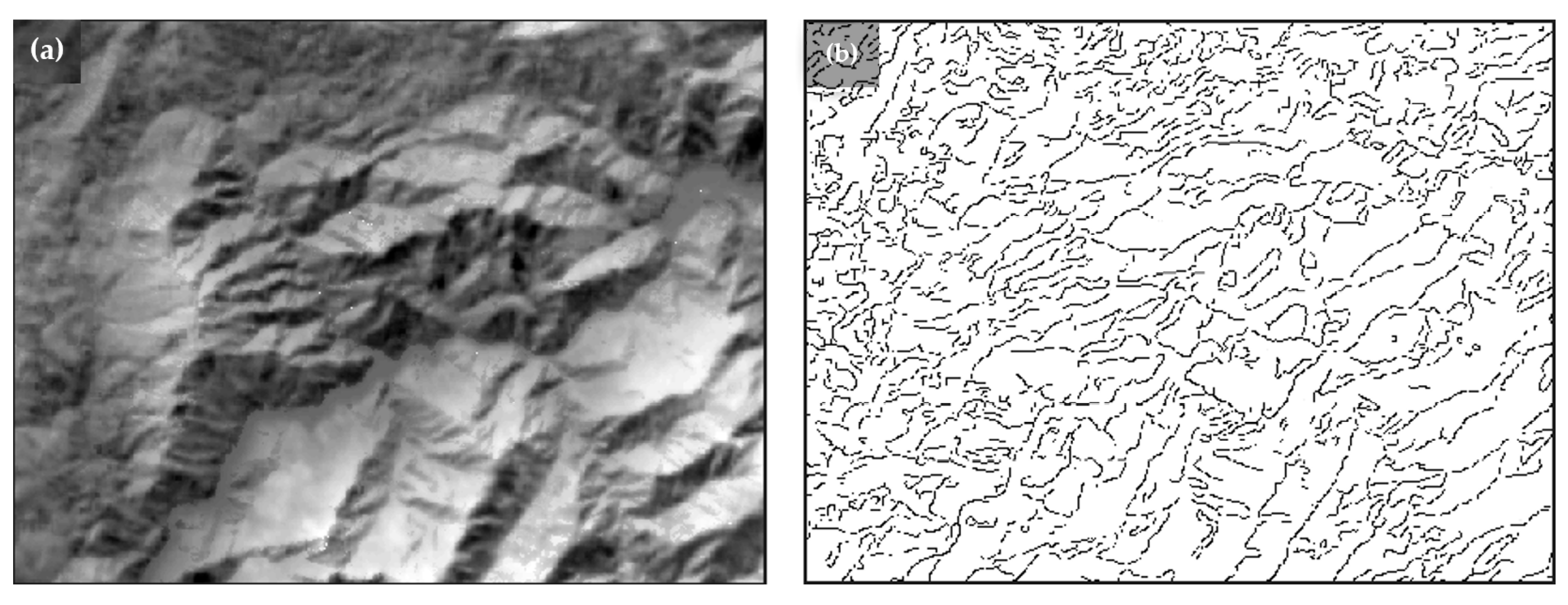
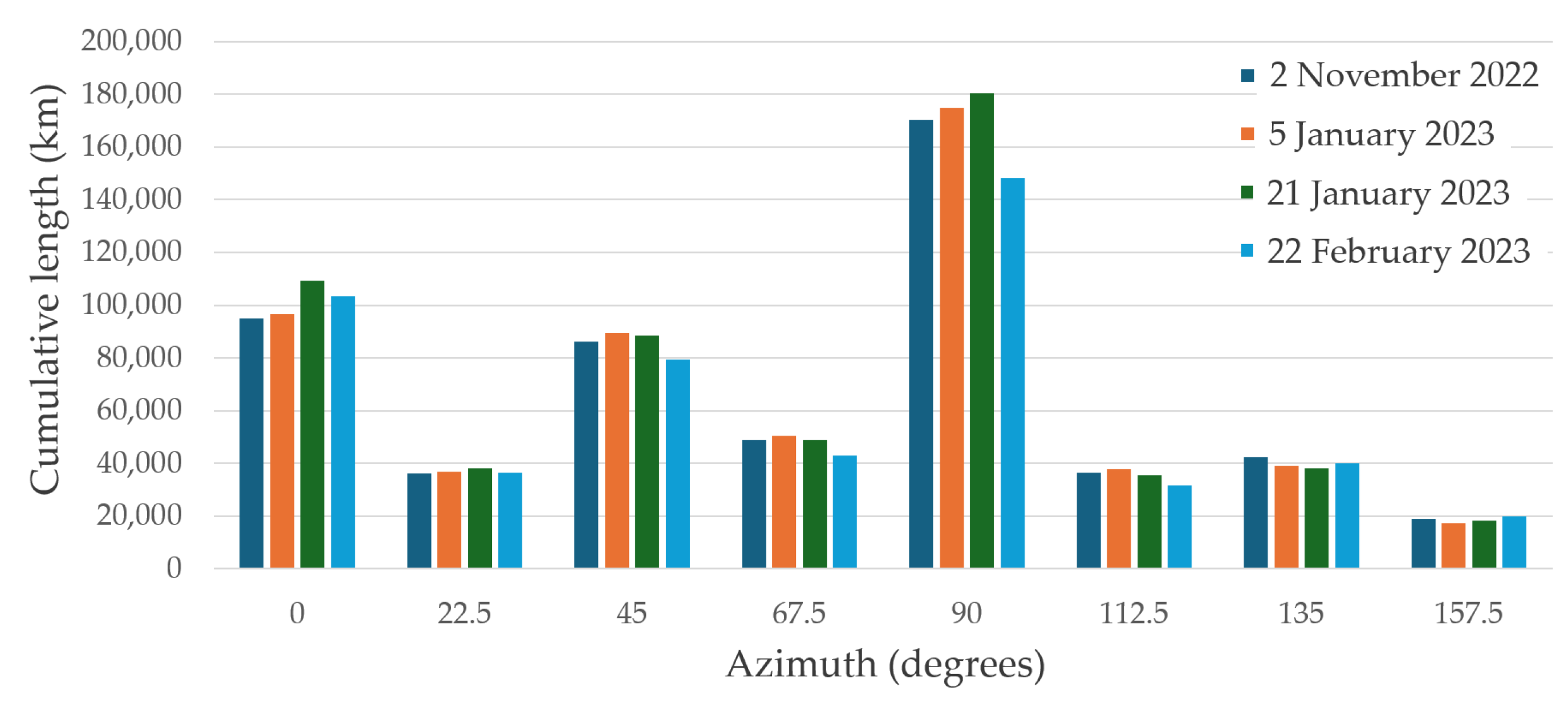
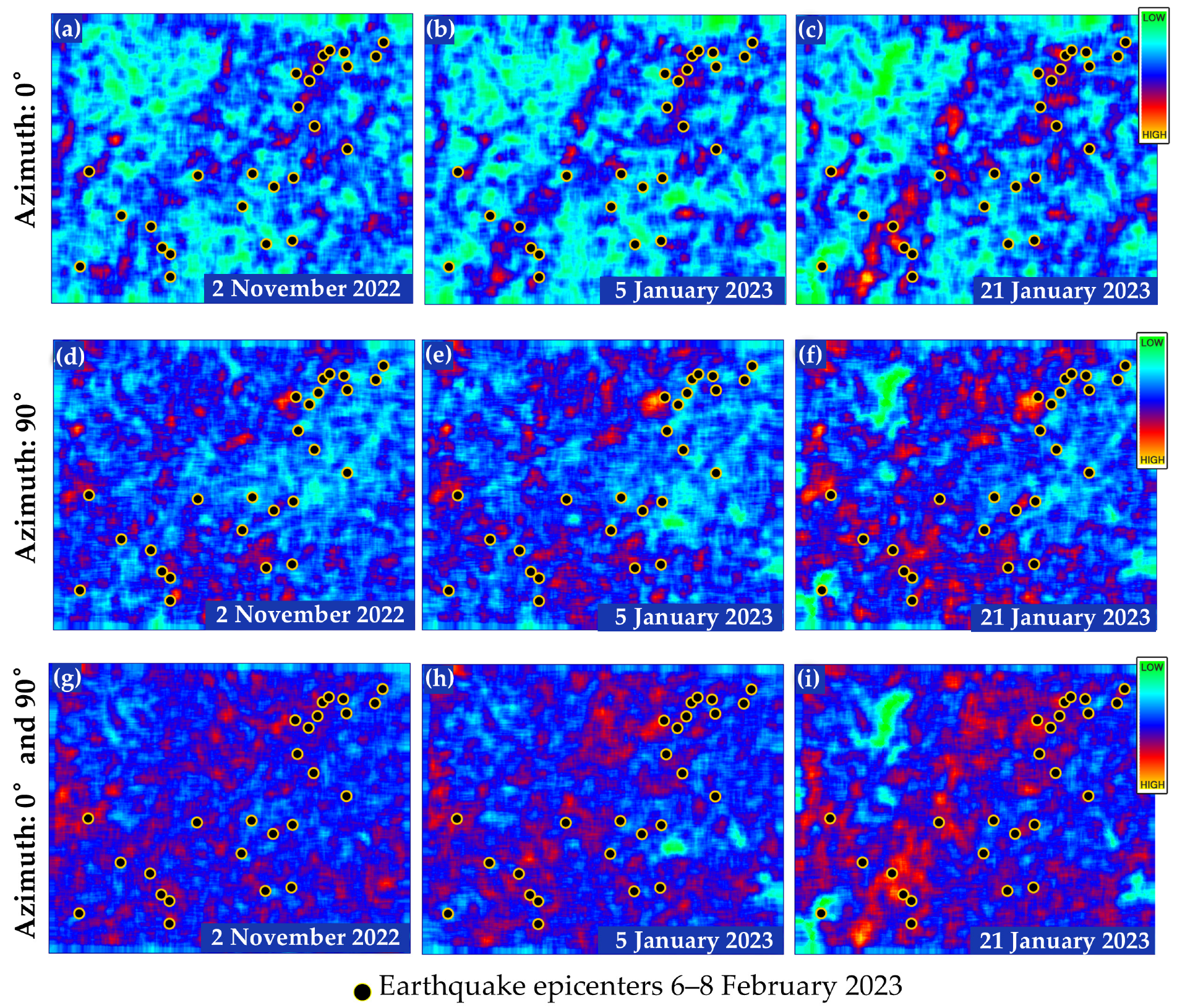
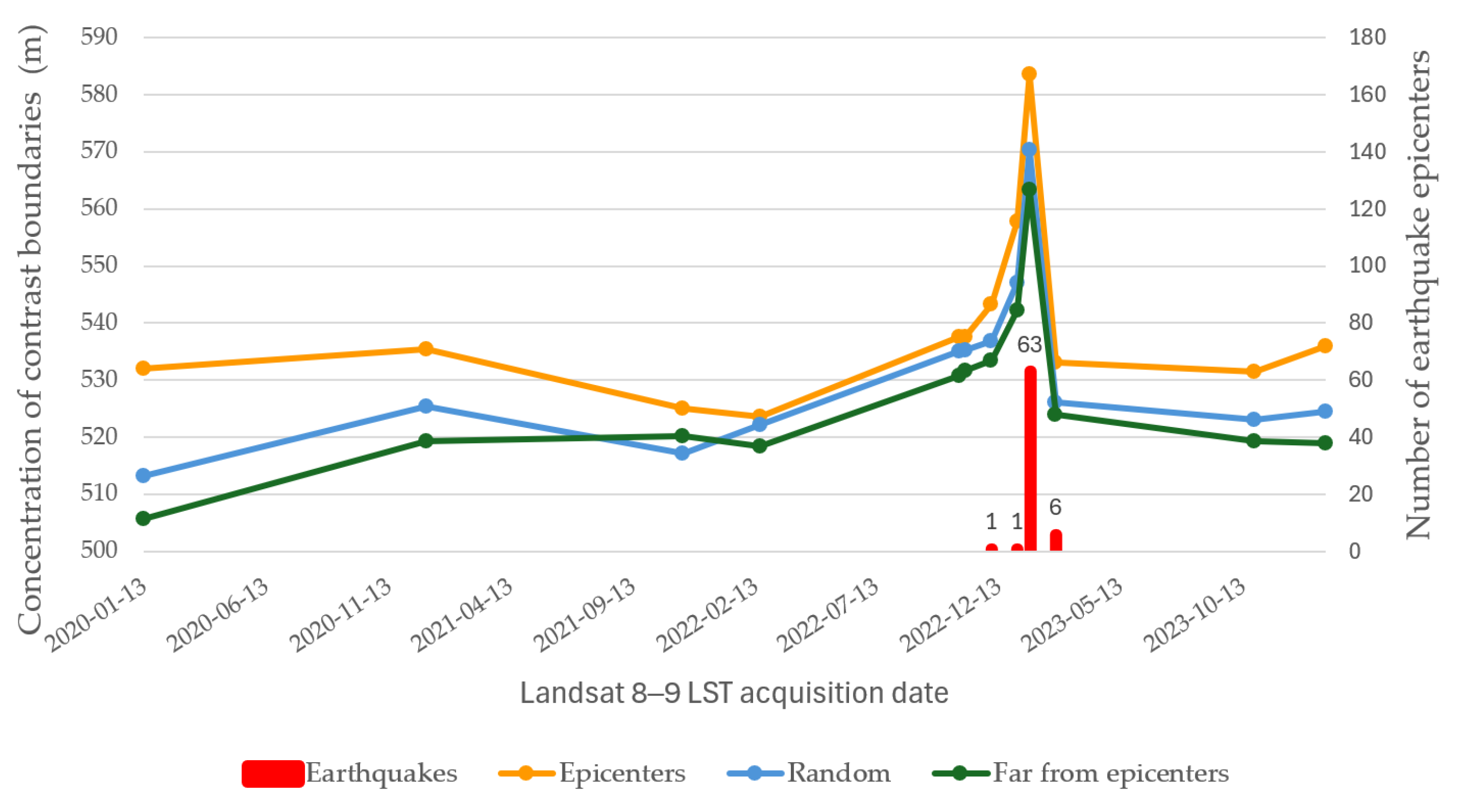
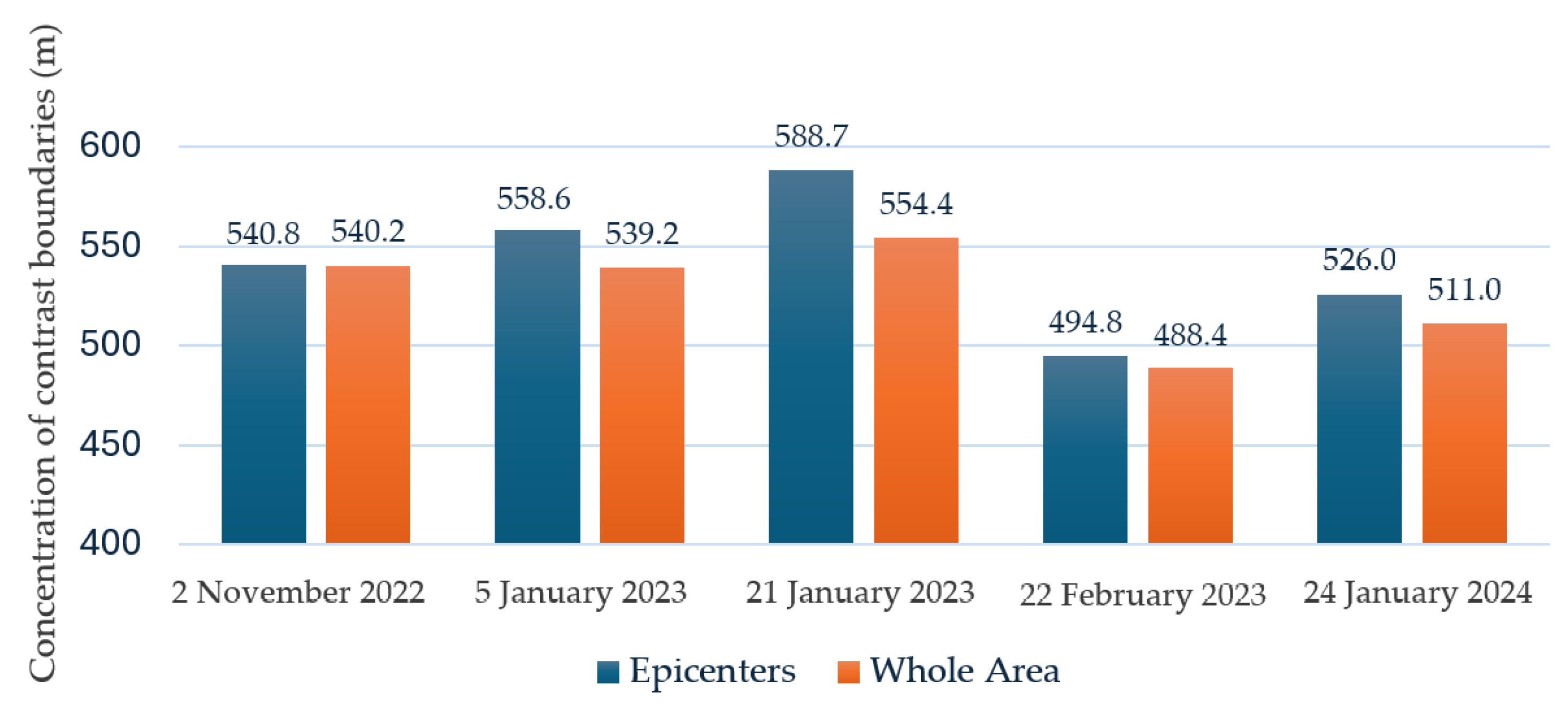
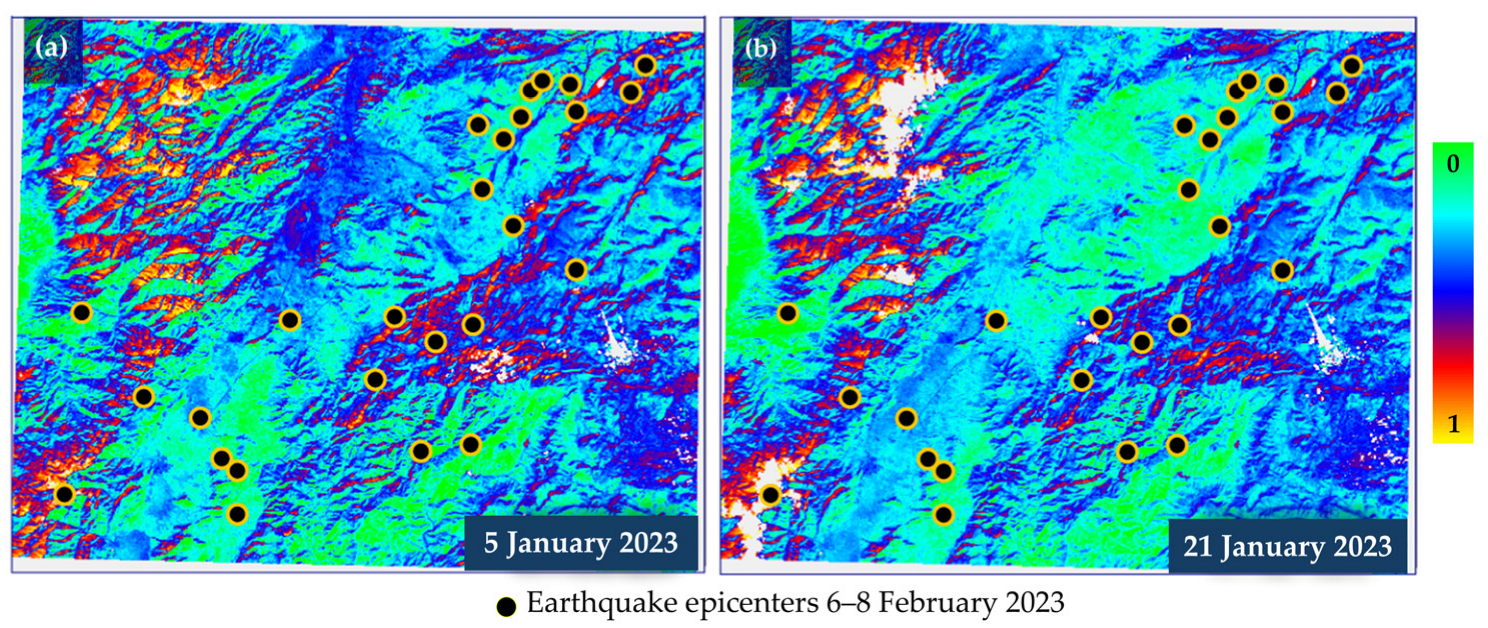
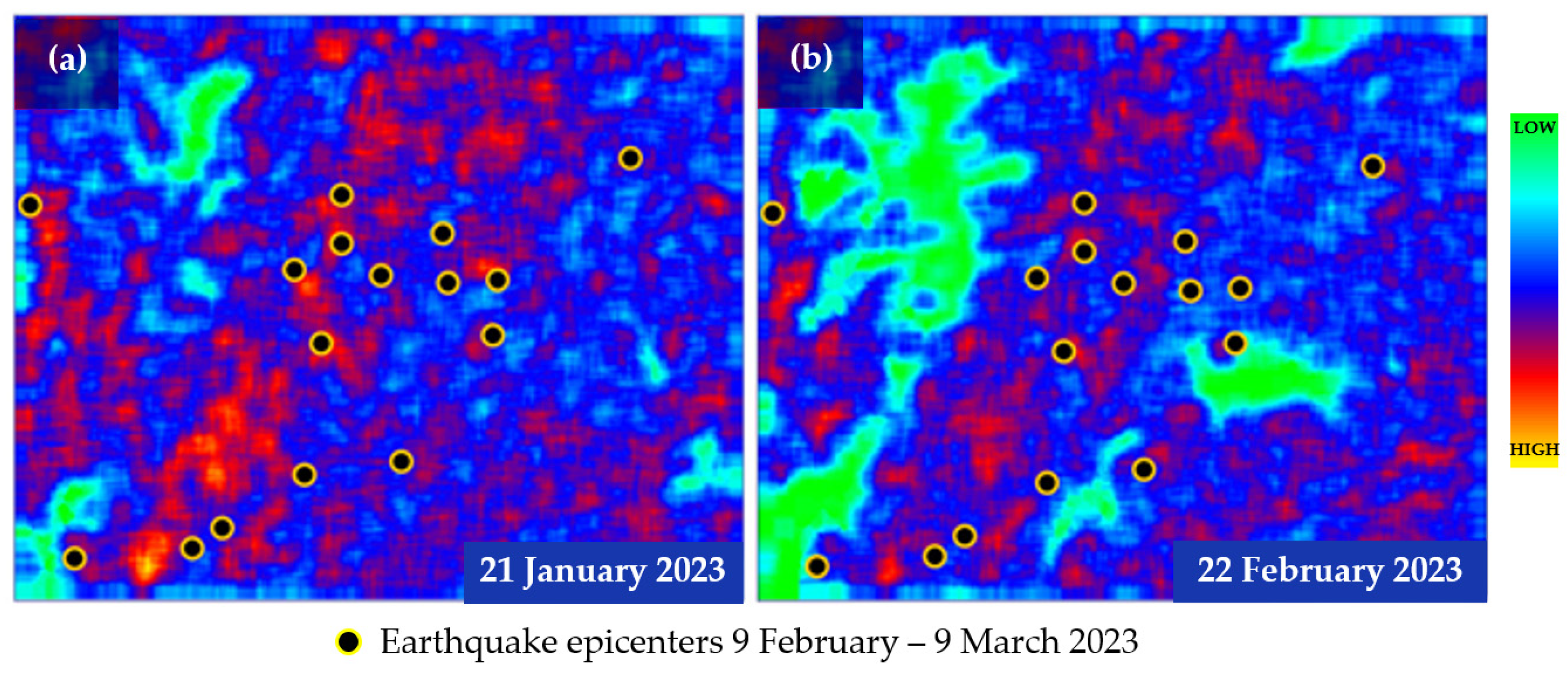
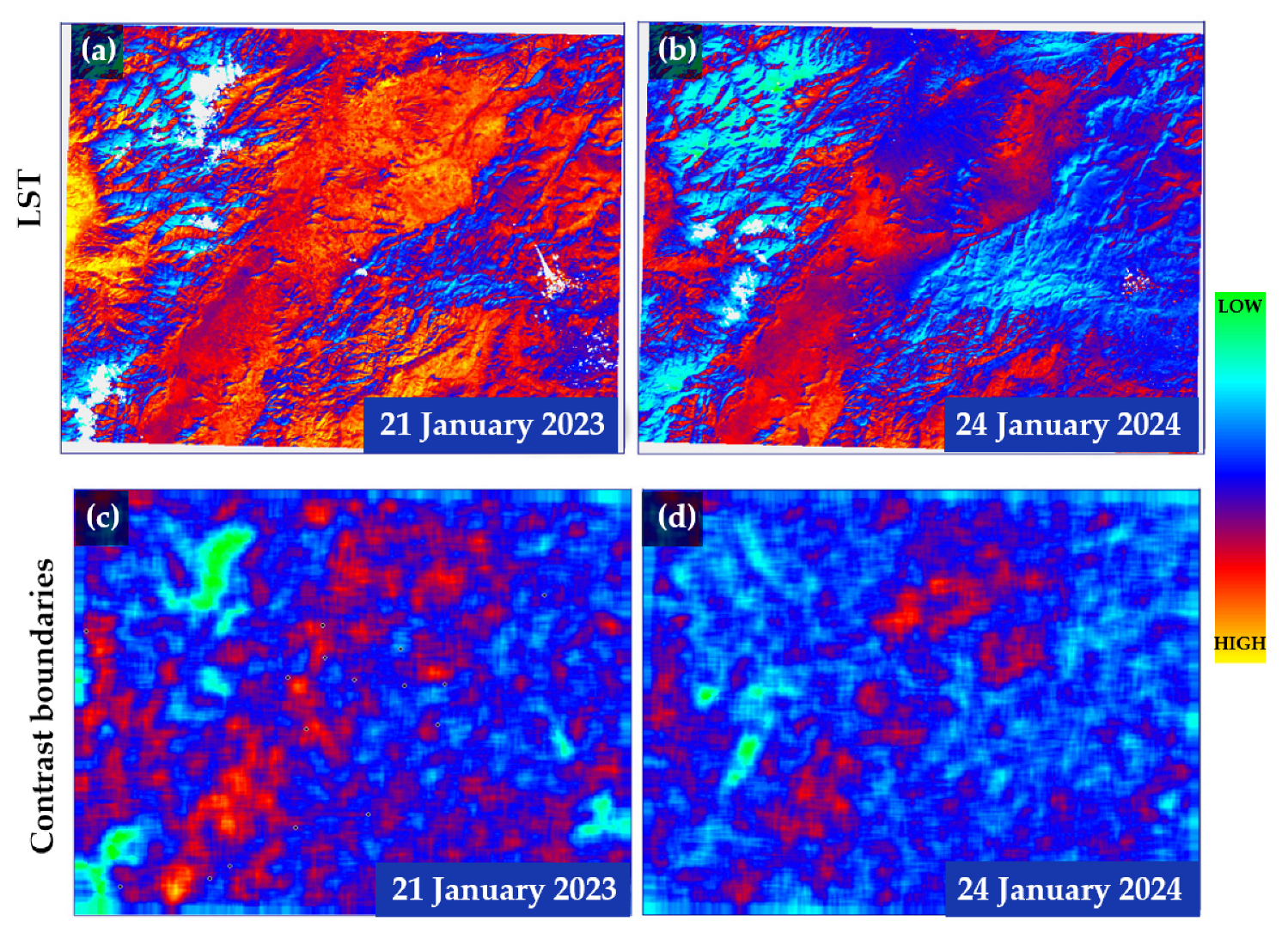
| Landsat 8–9 Acquisition Date and Time | Ground-Based Temperature (°C) | |
|---|---|---|
| 24 January 2024 | 08:09:32.80Z | 9.0 |
| 28 October 2023 | 08:09:42.73Z | 24.0 |
| 22 February 2023 | 08:09:37.88Z | 12.0 |
| 21 January 2023 | 08:09:50.18Z | 11.0 |
| 5 January 2023 | 08:09:55.33Z | 10.0 |
| 4 December 2022 | 08:10:04.26Z | 15.0 |
| 2 November 2022 | 08:10:09.37Z | 19.0 |
| 25 October 2022 | 08:09:57.91Z | 22.0 |
| 15 September 2022 | 08:15:58.31Z | 28.0 |
| 19 February 2022 | 08:09:32.84Z | 11.0 |
| 15 November 2021 | 08:09:51.53Z | 20.0 |
| 30 December 2020 | 08:09:48.01Z | 13.0 |
| 13 January 2020 | 08:09:41.57Z | 10.0 |
Disclaimer/Publisher’s Note: The statements, opinions and data contained in all publications are solely those of the individual author(s) and contributor(s) and not of MDPI and/or the editor(s). MDPI and/or the editor(s) disclaim responsibility for any injury to people or property resulting from any ideas, methods, instructions or products referred to in the content. |
© 2024 by the authors. Licensee MDPI, Basel, Switzerland. This article is an open access article distributed under the terms and conditions of the Creative Commons Attribution (CC BY) license (https://creativecommons.org/licenses/by/4.0/).
Share and Cite
Nikulin, S.; Sergieieva, K.; Korobko, O.; Kashtan, V. Using the Contrast Boundary Concentration of LST for the Earthquake Approach Assessment in Turkey, 6–8 February 2023. Earth 2024, 5, 388-403. https://doi.org/10.3390/earth5030022
Nikulin S, Sergieieva K, Korobko O, Kashtan V. Using the Contrast Boundary Concentration of LST for the Earthquake Approach Assessment in Turkey, 6–8 February 2023. Earth. 2024; 5(3):388-403. https://doi.org/10.3390/earth5030022
Chicago/Turabian StyleNikulin, Serhii, Kateryna Sergieieva, Olga Korobko, and Vita Kashtan. 2024. "Using the Contrast Boundary Concentration of LST for the Earthquake Approach Assessment in Turkey, 6–8 February 2023" Earth 5, no. 3: 388-403. https://doi.org/10.3390/earth5030022
APA StyleNikulin, S., Sergieieva, K., Korobko, O., & Kashtan, V. (2024). Using the Contrast Boundary Concentration of LST for the Earthquake Approach Assessment in Turkey, 6–8 February 2023. Earth, 5(3), 388-403. https://doi.org/10.3390/earth5030022





